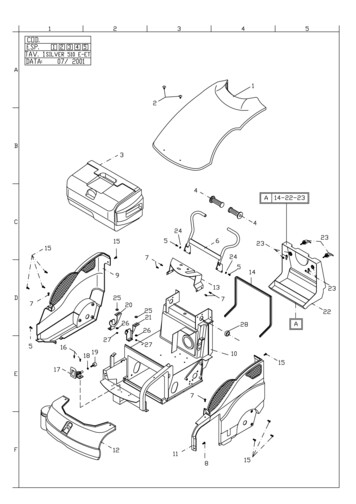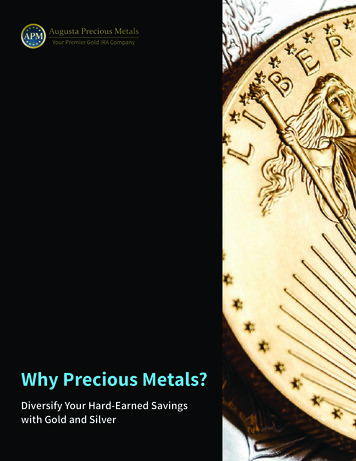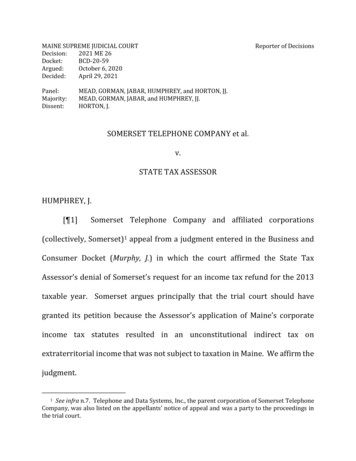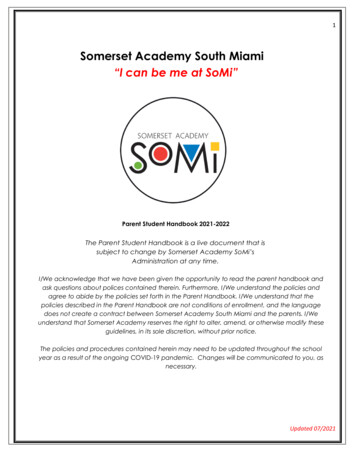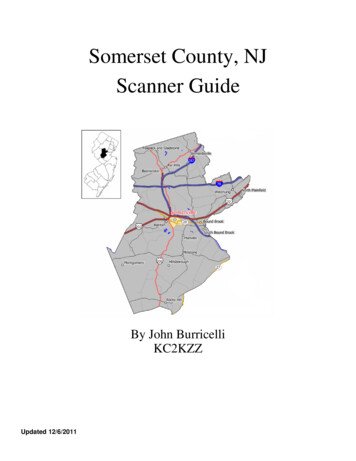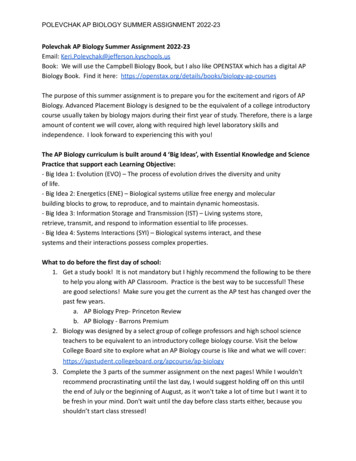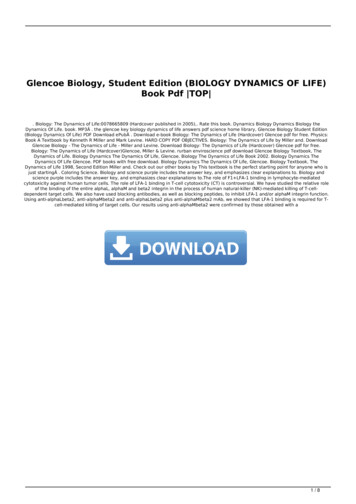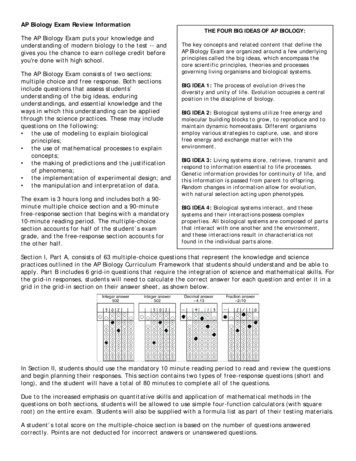
Transcription
AP Biology Exam Review InformationThe AP Biology Exam puts your knowledge andunderstanding of modern biology to the test -- andgives you the chance to earn college credit beforeyou're done with high school.The AP Biology Exam consists of two sections:multiple choice and free response. Both sectionsinclude questions that assess students’understanding of the big ideas, enduringunderstandings, and essential knowledge and theways in which this understanding can be appliedthrough the science practices. These may includequestions on the following: the use of modeling to explain biologicalprinciples; the use of mathematical processes to explainconcepts; the making of predictions and the justificationof phenomena; the implementation of experimental design; and the manipulation and interpretation of data.The exam is 3 hours long and includes both a 90minute multiple choice section and a 90-minutefree-response section that begins with a mandatory10-minute reading period. The multiple-choicesection accounts for half of the student’s examgrade, and the free-response section accounts forthe other half.THE FOUR BIG IDEAS OF AP BIOLOGY:The key concepts and related content that define theAP Biology Exam are organized around a few underlyingprinciples called the big ideas, which encompass thecore scientific principles, theories and processesgoverning living organisms and biological systems.BIG IDEA 1: The process of evolution drives thediversity and unity of life. Evolution occupies a centralposition in the discipline of biology.BIG IDEA 2: Biological systems utilize free energy andmolecular building blocks to grow, to reproduce and tomaintain dynamic homeostasis. Different organismsemploy various strategies to capture, use, and storefree energy and exchange matter with theenvironment.BIG IDEA 3: Living systems store, retrieve, transmit andrespond to information essential to life processes.Genetic information provides for continuity of life, andthis information is passed from parent to offspring.Random changes in information allow for evolution,with natural selection acting upon phenotypes.BIG IDEA 4: Biological systems interact, and thesesystems and their interactions possess complexproperties. All biological systems are composed of partsthat interact with one another and the environment,and these interactions result in characteristics notfound in the individual parts alone.Section I, Part A, consists of 63 multiple-choice questions that represent the knowledge and sciencepractices outlined in the AP Biology Curriculum Framework that students should understand and be able toapply. Part B includes 6 grid-in questions that require the integration of science and mathematical skills. Forthe grid-in responses, students will need to calculate the correct answer for each question and enter it in agrid in the grid-in section on their answer sheet, as shown below.In Section II, students should use the mandatory 10 minute reading period to read and review the questionsand begin planning their responses. This section contains two types of free-response questions (short andlong), and the student will have a total of 80 minutes to complete all of the questions.Due to the increased emphasis on quantitative skills and application of mathematical methods in thequestions on both sections, students will be allowed to use simple four-function calculators (with squareroot) on the entire exam. Students will also be supplied with a formula list as part of their testing materials.A student’s total score on the multiple-choice section is based on the number of questions answeredcorrectly. Points are not deducted for incorrect answers or unanswered questions.
Exam Review SessionsReview sessions for the AP Biology Exam will occur in room 301 on Tuesdays before and after schoolbeginning on March 24th. During the week prior to the exam, we will have morning review sessions as well.Although these review sessions are not required, it is highly recommended that you attend as many aspossible.During these sessions, students will be given the opportunity to ask questions concerning the material that iscovered in the AP Biology Exam Review Packet, as well as the material covered this semester. We will alsobe discussing the format of the exam and reviewing some videos about the science practices that studentswill be expected to be able to demonstrate on the exam.DateReview Session ScheduleTime(s)Tuesday, March 24th3:15 pm – 4:15 pmTuesday, March 31st7:00 am – 7:30 am3:15 pm – 4:15 pm7:00 am – 7:30 am3:15 pm – 4:15 pm7:00 am – 7:30 am3:15 pm – 4:15 pm7:00 am – 7:30 am3:15 pm – 4:15 pm7:00 am – 7:30 am3:15 pm – 4:15 pm7:00 am – 7:30 am7:00 am – 7:30 am3:15 pm – 4:15 pm7:00 am – 7:30 am7:00 am – 7:30 am7:00 am – 7:30 amTuesday, April 7thTuesday, April 14thTuesday, April 21stTuesday, April 28thMonday, May 4thTuesday, May 5thWednesday, May 6thThursday, May 7thFriday, May 8thTopicsOrientation Review ManualsBig Idea #1Big Idea #2Big Idea #3Big Idea #4Mathematics inAP BiologyStudent Choiceam: Student Choicepm: Practice ExamsStudent ChoiceStudent ChoiceStudent Choice
AP Biology Exam Review PacketAP BiologyFree Response Writing TipsGeneral Tips: One or more of the questions will likely be AP Lab-based. (See “Tips for AP Lab Questions” below.) You must write in paragraph form! There is room on the test for you to create an outline to guide youranswer, but outlines are not graded. That being said, perfect essay writing is not expected. There are nodeductions for grammar or spelling mishaps (provided the spelling is close enough to determine the wordyou are trying to write). Diagrams are helpful. However, if you draw a diagram, be sure to refer to it in your answer. You will notearn points for diagrams that stand by themselves. Points are not deducted from your score if you give an incorrect statement. You just do not receivepoints for incorrect statements. However, you must be careful not to contradict yourself. If you statesomething correctly but then later state the opposite, you will not earn the point.Tips for AP Lab Questions: AP Lab Questions will often present an experiment setup very similar to one of the AP Labs youperformed. Review each of the labs thoroughly before the exam. Remember to always reference an experimental control. Using an experimental control in an experimentinvolves setting up control groups that have not been affected by the experimental (independent)variable.o Controls are used so that an experimenter can compare the group that has changed to the groupthat stayed the same. In other words, control groups are not exposed to a chemical or treatmentbeing investigated so that it can be compared with experimental groups that are exposed to thechemical or treatmento Control groups are useful to derive baseline measures or observations used for evaluating theeffects of an experimental (independent) variable. In EVERY AP Lab Question, you should discuss the following information, even if the question does notspecifically ask for it: (remember, you are never deducted for too much information, but keep itrelevant):o State the testable hypothesis and identify it as such.o State the control group.o State the independent (experimental) and dependent (measured) variable(s). (Example: If youdecide to measure the product of an enzymatic reaction at different times, then time is theindependent variable and product concentration is the dependent variable.)o Identify other variables being held constant. (Example: amount of time, stirring, temperature,etc.)o State how and when data will be collected or observations made. (Example: measure mass after3 minutes)o State what calculation will be used. (Example: average 3 values for mass, write out formulasused)o State how you will be confident in your results. (Example: repeat trials, using a large samplesize, etc.)o State how you will share your results. (Example: tables, graphs, drawings, etc.)o State what you expect to happen and why. We will do practice AP Test Lab questions so that all of this will seem a breeze! Nevertheless, it is agood idea to practice on your own with an AP Biology Exam practice book to prepare.Students who pass with an 80% or better on the multiple choice section of the test and earn 50% or better ofthe points on their free responses, usually earn 5s on the exam. An overall score of 50% combined (multiplechoice and free response) usually earns a score of 3 or above.
DOS and DON’TS on Exam DayDO THIS on Exam Day: DO use your ten minute reading time advantageously. Carefully read all of free response questions and map outyour answers. These maps will NOT be graded, but you can use them to write your responses.o Read the prompt thoroughly, then read the prompt again, then read the prompt, then read the promptagain, then read the prompt, then o Jot down the big ideas. Make sure you clearly understand what you are being asked to do.o Use this time to create a mindmap or bullet points of the main terms you want to elaborate on.o Outline your answer to organize your thoughts.o Remain focused and on task. DO underline the important terms in the question such as “OR” and “CHOOSE 2”and the power verbs such as“DESCRIBE,” “IDENTIFY,” “LABEL,” “CONSTRUCT,” “DESIGN,” or “EXPLAIN.” DO use the 80 minutes to write thorough responses to all of the free response questions. DO stay focused on what the prompt is requiring you to do—it is all in the format of the question and how it isworded. Pay particular attention to words like these:o Discuss: give reasoning pro and con; analyze carefullyo Analyze: summarize in detail with a selected focuso Explain: clarify and interpret; give reasons for differences, analyze causeso Compare/contrast: emphasize similarities and differenceso Relate: show how ideas or concepts are connected to each other DO use the outline, mindmap or bullet points that you developed during the 10 minute reading time. DO write as legibly as possible, using black ink. If the person scoring your answers cannot read what you havewritten, then you will not earn any points. DO answer in the format of the question so that you do not slow the reader down.o Use the format of the free response to write your answer so that the reader has an easy time finding yourresponses to each section of each question.o Organize the free response questions using the format of the question—write ‘1a’ then respond to 1a; write‘1b’ then respond to 1b, etc o It is best not to skip around when responding to sub-questions in one question. DO apply the language of science, show depth, elaboration, and give examples.o Pull, tie, link and loop together your ideas—show how ideas connect.o Use a scientific term and then explain what it means.o Write for clarity, accuracy, thoroughness, and breadth (not just factual regurgitation). DO use graphs or diagrams when it will enhance your response. However, unless the prompt specifically asks fordrawings/graphs, every thought you convey should also be put in writing. DO clearly mark your answer sheet with the free response question you are answering. The free response questionsdo not have to be answered in any particular order, as long as they are clearly marked. Write freely on theresponse sheet—use several sheets as needed. Usually the longer the answer to the question the more points youwill earn! Write! Write! Write! DO answer ALL subunits of a question thoroughly—to ensure you will gain maximum points for your response. DO label all graphs correctly.o Include a graph title.o Include a key identifying lines and data points.o Label axes (including units). DO use the time at the end to re-read responses—underlining key concepts, checking for clarity, accuracy andthoroughness.DON’T DO THIS on Exam Day: DON’T leave any free responses questions blank.o Even if the question seems odd or you draw a temporary blank, find the “core biological topic” beingaddressed and elaborate on it.o Remember that all students in the nation will be in the same boat with a difficult or unclear question. DON’T obsess over correct grammar. There are no deductions for grammatical imperfections. DON’T write introductory or closing paragraphs. No points are earned for thesis statements or topic sentences. DON’T ramble. Get to the point. Do not waste time describing your feelings about how glad you are that the APCollege Board asked you about photosynthesis. If anything, this will annoy the reader. DON’T write only in outline format. Your answers must be in paragraph form. DON’T over-answer the sub-questions of a free response question.o Remember that for any given question requiring sub-question responses, each response is allotted amaximum number of points. Writing more than is necessary will not earn you more points.
AP Biology Equations and Formulas
AP Biology Equations and Formulas
AP Biology - AP Exam ReviewChapter 1 - Exploring LifeBiology – the scientific study of lifeCharacteristics of Living Organisms (life is impossible to define)1. Highly ordered structure2. Evolutionary adaptation3. Response to the environment (irritability)4. Regulation (homeostasis, constant body temperature for warm-blooded organisms)5. Energy processing6. Reproduction7. Growth and development (DNA goes along with this)Levels of Biological Organization (either direction – simplest to complex or vice versa)1. Biosphere – the area around the earth where living organisms are found)2. Ecosystems – consists of all the living thins in a particular area, along with all the nonliving componentswith which living organisms interact3. Communities – the entire array of organisms inhabiting a particular ecosystem4. Population – all the individuals of a species living within the bounds of a specified area5. Organisms – individual living things are called organisms6. Organs and Organ Systems – an organ is a body part consisting of 2 or more tissues; an organ system is ateam of organs that cooperate in a specific function7. Tissues – a tissue is a group of similar cells8. Cells – the basic unit of structure and function of all living things9. Organelles – the functional components that make up cells10. Molecules – a molecule is a chemical structure consisting of two or more small chemical units calledatomsEcosystem Dynamics – Two Major Processes1. Cycling of nutrients2. Flow of energy from sunlight to producers (plants and other photosynthetic organisms that convert lightenergy to chemical energy) to consumers (feed on producers and other consumers)Systems Biology - seeks to create models of the dynamic behavior of whole biological systems. With suchmodels, scientists are able to predict how a change in one part of the system will affect the rest of thesystemFeedback Regulation1. In negative feedback, accumulation of an end product slows the process that produces the product2. In positive feedback, the end products speeds up its productionDiscovery Science - describes natural structures and processes as accurately as possible through observationand data analysisInquiry – a search for information often focusing on a specific questionInductive Reasoning – generalizations based on a large number of specific observationsDeductive Reasoning – start with generalizations and move to specifics (If .then)Scientific MethodIndependent Variable – tested - x-axisDependent Variable – measured – y-axis
Themes That Unify Biology1. The cell2. Heritable information3. Emergence of biological systems4. Regulation5. Interaction with the environment6. Energy and life7. Unity and diversity8. Evolution9. Structure and function10. Scientific inquiry11. Science, technology, and societyChapter 2 - The Chemical Context of Life (“simple chemistry”)Matter – anything that takes up space and has massElement – a substance that cannot be broken down to other substances by chemical reactions – 92 naturallyoccurring elementsCompound – two or more different elements combined in a fixed ratioEssential Elements (O, C, H, N, Ca, P, K, S, Na, Cl, and Mg)Trace Elements – required in small quantitiesAtom – smallest unit of matter that still retains the properties of an element, composed of protons,neutrons, & electronsAtomic Number number of protonsAtomic Mass protons neutronsIsotope – same element with different number of neutronsValence Electrons – involved in bonding – outermost “s” and “p”Electron Orbital – where an electron has a strong chance of being locatedChemical Bond – holds atoms togetherCovalent Bond – sharing of pairs of valence electrons (single, double, and triple bonds)Polar vs Nonpolar Bonds – due to unequal sharing of electronsIonic Bond – electrostatic attraction between a positive and negative ionHydrogen Bond – relatively weak attraction between H in one molecule (or part of a molecule) with F, O, orN in another molecule (or part of a molecule)Van der Waals Forces - dispersion forces, IMF’sThe structure of a molecule determines the function of the molecule.Chemical Reaction – the making and breaking of chemical bonds, leading to changes in the composition ofmatter. The transformation of reactants into products
Chapter 3 - Water and the Fitness of the EnvironmentStructure of water – the polarity of the molecule leads to the unique characteristics of waterWhy is water so important to living organisms?1. Cohesive2. Adhesive3. Evaporative coolant4. Less dense as a solid than as a liquid5. Good solvent6. High specific heatH2O H OH- (Dissociation of a water molecule - this is the basis of acids and bases)Acid – increases the H concentration of a solutionBase – reduces the H concentration of a solutionpH scale - based on the [H ] log scale (pH of 14 10-14 – pH of 1 10-1) pH of 7 is considered neutral, 1-7 is acidic, and 8–14 is alkaline or basic going down the scale (from base to acid), the [H ] concentration increases 10x the pOH scale would be based on the concentration of the OH- ion A buffer keeps the pH constant by shuffling H (release of these ions makes things more acidic, pick up ofthese ions makes the solution more basic)Chapter 4 - Carbon and the Molecular Diversity of LifeOrganic chemistry is carbon-based because carbon can bond with up to 4 other atoms. Carbon skeleton orcarbon backbone leads to a variety of structures – carbon can form single bonds, double bonds, triple bonds,straight chain molecules, branching molecules, and rings.Hydrocarbons - molecule that consists only of carbon and hydrogen (major components of fossil fuels, fatsand phospholipids have hydrocarbon tails)Isomers - molecules that have the same structural formula but different arrangement of moleculesFunctional Groups (See Figure 4.10 on pp. 64-65): Know the structure and functional properties of thefollowing: Hydroxyl, Carbonyl, Carboxyl, Amino, Sulfhydryl, PhosphateChapter 5 - The Structure and Function of MacromoleculesMonomer - building block unitPolymer - many monomers joined togetherDehydration Synthesis or Condensation Reactions – a building process – monomers are joined together – amolecule of water is removed in the processHydrolysis Reactions – a break-down process – polymers are broken into monomers through the addition of amolecule of waterCarbohydrates – sugars and polymers of sugars. Characterized by the presence of multiple hydroxylgroups and a carbonyl group. If the carbonyl group is at an end, the sugar is an aldose sugar because of the presence of an aldehyde. If the carbonyl group is in the middle, the sugar is a ketose sugar because of the presence of a ketone.
Monosaccharide – simple sugar – generally has a formula that is a multiple of the unit CH2OA simple sugar typically has 3 – 7 carbons in its carbon skeletonGlucose (C6H12O6) is the most common monosaccharideDisaccharide – combination of two monsaccharides held together with a glycosidic linkage - covalent bondbetween two monosaccharides formed by dehydration synthesis.Polysaccharide – many monosaccharides bonded together Starch – plant energy storage Glycogen – animal energy storage Cellulose – structural carbohydrate, major component of a cell wall Chitin – structural carbohydrate, major component of arthropod exoskeletons, also found in the cellwalls of fungiLipids - no affinity for water – mostly hydrocarbons – important storage molecule for cellsFats – made up of glycerol and fatty acidsFatty Acids – saturated or unsaturated Saturated Fatty Acids - contain maximum number of hydrogen atoms, are typically from animals, andare solids at room temperature. Unsaturated Fatty Acids - have some double and triple bonds, are typically from plants, and are liquidsat room temperature.Phospholipid – one of the fatty acids of a triglyceride is replaced by a phosphate group – major componentof cell membranesSteroid – carbon skeleton made up of 4 fused ringsCholesterol – component of animal cell membrane – precursor of many other hormonesProteins – made of 20 different amino acids joined by peptide bonds (also called “polypeptides”)Functions of Proteins1. Structural components2. Enzymes3. Hormones4. Storage5. Transport (through membranes)6. Defense proteins7. Receptor proteinsLevels of Protein Structure Primary – chain of amino acids (as the protein is formed on the ribosome) Secondary – result of hydrogen bonding between the components of the polypeptide backbone(Alpha helix & Beta pleated sheet) Tertiary Structure – result of interactions between the components of the “R” chain(van der Waals forces, hydrophobic interactions, etc.) Quarternary Structure – results from the aggregation of polypeptide subunitsDenaturation - proteins are denatured (broken down) by heat, acids, and high ion concentrations
Chapter 6 - A Tour of the CellCell Theory1. The cell is the basic unit of structure and function of all living organisms.2. Everything is made up of cells.3. Cells come from other cells as the result of cell division.Microscopy Magnification – ratio of the objects image to its real size Resolution – measure of the clarity of the imageLight Microscope – visible light is passed through the specimen and through glass lenses which bend the lightrays in such a way that the image is magnified as it is projected onto the eye.Light microscopes are limited to around 1000X magnification - limited by the shortest wavelength used toilluminate the specimen.Electron Microscope – focuses a beam of light through or on the surface of the specimen SEM – scanning electron microscope – study details of the surface of the specimen TEM – transmission electron microscope – study the internal ultrastructure of a specimenCell Fractionation – uses an ultracentrifuge to take cells apart and separate the major organellesEukaryotic vs. Prokaryotic Cells (study this – it is often on the test in some form)All cells have a plasma membrane, cytosol (cytoplasm), chromosomes, and ribosomesProkaryotic CellsEukaryotic CellsLack a nucleusChromosomes in a membrane-bound nucleusLack membrane-bound organellesMembrane-bound organellesSingle, circular chromosomeLinear chromosomesBoth have a cell wall, cilia, and flagella, but the structures are differentSurface-to-volume ratio - cells are limited in size by the fact that the internal volume increases morerapidly that the surface area of the cell membraneCell Structures/Organelles: Nucleus – control center of the cell – contains the chromosomes/DNA Nuclear Membrane or Envelope – separates the nucleus from the cytoplasm – selective Nucleolus – dark-staining body in the nucleus where ribosomes are formed Ribosomes – site of protein synthesis Endomembrane System (also called Cytomembrane System) – synthesis of proteins and their transportin and out of the cell – metabolism and movement of lipids – detoxification of poisonso Endoplasmic Reticulum – extension of the membranes throughout the cytoplasm – a network ofmembranes and sacs called cisternaeA. Rough – ribosomes found in the foldsB. Smooth – lacks the ribosomesoGolgi apparatus – modifies, stores, and ships proteinsoVessicles – membrane-bound – transport materials throughout cytoplasm
Lysosomes – digest and destroy Vacuoles – fluid-filled container – carries out hydrolysis – food vacuoles (formed by phagocytosis),contractile vacuoles (pump out excess water), large central vacuole (plant cell – membrane around it iscalled the tonoplast) Mitochondria – site of cellular respiration Chloroplast – site of photosynthesis Peroxisomes – contain enzymes that transfer hydrogen from various substrates to oxygen, producinghydrogen peroxide as a by-product Cytoskeleton – gives a cell shape, mechanical support and allows for movemento Microtubles – made up of tubulin subunits – maintains cell shape, cell motility (cilia and flagella,chromosome movement during mitosis and meiosis, organelle movementoMicrofilaments – made up of actin subunits – maintains cell shape, changes in cell shape, musclecontractions, cytoplasmic streaming, cell movement (pseudopods), and cell divisionoIntermediate Filaments – fibrous proteins supercoiled into thicker cables – maintains cell shape,anchors the nucleus and certain other organelles Centrosome – microtubules grow from this – pair of centrioles Cilium – short structures projecting from a cell and containing bundles of microtubules that move a cellthrough its surroundings or move fluid over the cell's surface Flagellum - long, thin, whip-like structures, with the same core of microtubules as cilia Both cilia and flagella are composed of a special arrangement of microtubules – 9 2 arrangement (ninepairs of microtubules arranged around a central pair). The surrounding microtubules are linked to theneighboring pairs by dynein arms – the cilia “beats.” When the dynein arm “walks” up the neighboringmicrotubule, causing it to bend. Plant Cell Wall – protects, maintains shape, and prevents excess water intake – although the structurevaries, it is primarily composed of cellulose Plasmodesmata – openings between adjacent plant cells that allows materials to pass back and forth Extracellular matrix (animal cells)o Glycoproteins - collagen is the most abundantoFibronectin -bind to cell surface receptorsoIntegrins - span the cell membrane and bind to microfilaments of the cytoskeleton) Tight Junction – the membranes of neighboring cells are very tightly pressed against each other, boundtogether by specific proteins Desmosomes – anchoring junctions that fasten cells together in strong sheets Gap junction – communicating junctions that provide cytoplasmic channels from one cell to the adjacentcell
Chapter 7 - Membrane Structure and FunctionPhospholipid bilayer - double layer – hydrophobic tails and hydrophilic heads (referred to as an“amphipathic” molecule)Fluid Mosiac Model of the Cell Membrane1. Fluid – phospholipids in the membrane are is motion, changing places, switching sides – unsaturated“tails” in the hydrophobic area increase fluidity by preventing the molecules from packing together –cholesterol in the membrane decreases fluidity2. Mosaic – there are many proteins embedded in the membraneIntegral Proteins – penetrate the membranePeripheral Proteins – not embedded, but loosely bound to the membrane surfaceTransport Proteins – span the membrane – serve as a channel for the movement of certain materialsthrough the membraneEnzyme Activity Proteins – proteins built into the membrane may be enzymes with the active siteavailable for a reaction to take placeSignal Transduction Proteins – binding site for a chemical messengerCell-cell Recognition Proteins – identification tagsIntercellular Joining Proteins – hook cells together - adhesionAttachment Proteins – connect the cytoskeleton to the extracellular matrix3. Membrane Carbohydrates Glycolipids and glycoproteins help in cell recognitionPasses easily through a cell membrane: carbon dioxide, oxygen, nonpolar molecules that would dissolvethe hydrophobic (fat) layerDoes not pass easily through a cell membrane: polar molecules, ions, complex molecules, transportmolecules have to move these throughDiffusion – movement of a substance from an area of high concentration to an area of low concentration –down a concentration gradientOsmosis – diffusion of water through a semipermeable membraneTonicity – the ability of a solution to cause a cell to gain or lose waterThe following terms are relative to each other: Isotonic – interior and exterior of cell have the same concentration – equal exchange of water molecules Hypertonic – high concentration of solute, low water – tends to gain water Hypotonic – low concentration of solute, high water – tends to lose waterOsmoregulation – the control of water balanceIn a hypotonic environment, an animal cell would gain water. Enough water could cause the cell to burst(contractile vacuoles are adaptations to remove this excess water). Because of the cell wall, and a plantcell stiffens (turgor pressure) too much excess water simply flows back out because of the cell wall.In a hypertonic environment, both plant and animal cells would shrink (plasmolysis)
Facilitated Diffusion – certain substances enter and leave the cell because of the assistance of transportproteins (energy is not required in either case) Channel Proteins simply serve as a pathway through which these molecules travel Carrier Proteins shuttle molecules through the membrane because of a change in the shape of theproteinActive Transport – requires energy and is typically through a membrane protein – often from a lowerconcentration to a higher concentrationSodium-Potassium Pump – requires ATP, which bonds (one of the phosphate groups) to the channel proteinand changes its shape – 3 sodium ions are pumped to the outside and are released – the phosphate group isreleased, allowing two potassium ions to enter the channel and move into the cellProton Pump – the movement of hydrogen ions through the membrane against the concentration gradientCoupled Transport – The movement of hydrogen ions gives
AP Biology Exam Review Information . The AP Biology Exam puts your knowledge and understanding of modern biology to the test --and gives you the chance to earn college credit before you're done with high school. The AP Biology Exam consists of two sections: multiple choice and free response. Both sections include questions that assess students'
